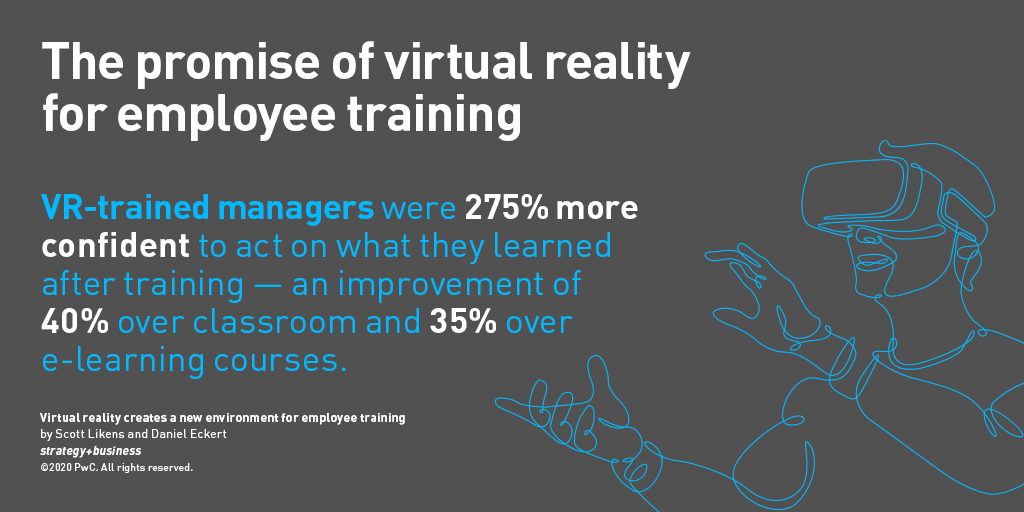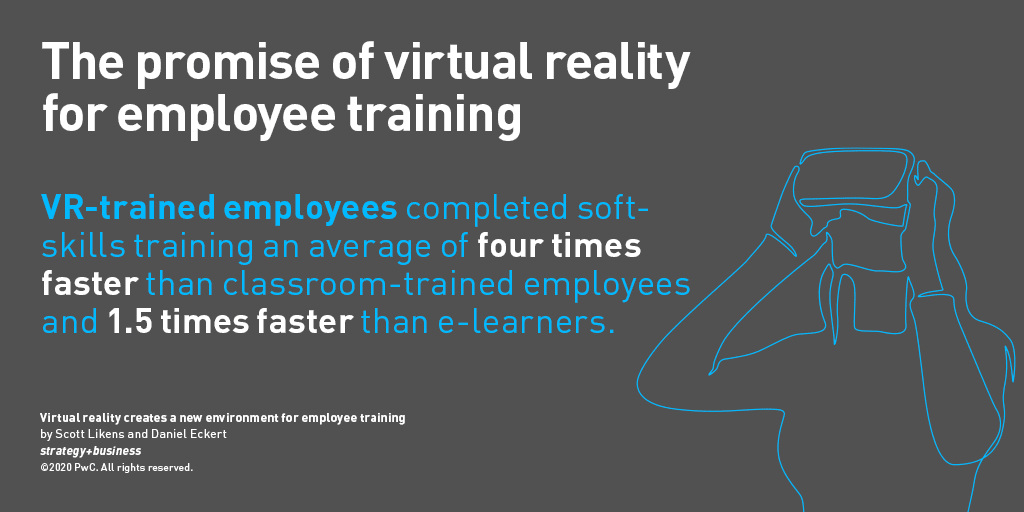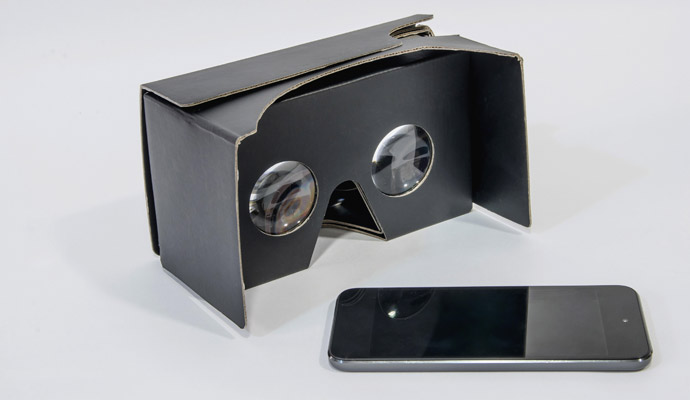Virtual reality creates a new environment for employee training
A new study finds that VR-led soft-skills training can be engaging, fast, and cost-effective.
The future of learning and development is unfolding in a typical conference room, with potted plants, a coffee machine, and windows overlooking the street below. A manager walks in and takes a seat at the table with colleagues. To hone her inclusive leadership skills, she’s taking part in a hiring committee exercise and is about to be briefed on a recent round of candidate interviews. The manager has a pile of resumes and notes in front of her and is prepared to discuss and ultimately decide whom to hire. When it’s over, she gets up to leave — and removes her virtual reality (VR) headset.
The employee we just described was a manager at PwC, selected from a group of more than 1,600 newly promoted managers in 12 locations across the United States. They were taking part in a study — to our knowledge the largest study of VR’s effectiveness for soft-skills training to date — to evaluate the benefits of three types of learning: classroom (in-person), e-learning (online), and v-learning (virtual reality). Each participant took a training course on inclusive leadership in one of these three modalities, and was assessed prior to and immediately after the course, as well as 30 days later. A majority (78 percent) of PwC’s VR soft-skills study participants preferred v-learning to more traditional types of training.
This finding comes at an opportune moment for employers confronting a looming challenge: Their workforce needs to upgrade their skills, but in-person training may not be an option for the foreseeable future. Even when returning to work and to classroom training is viable again, things may look fundamentally different as a result of workplace redesign. PwC’s latest CEO Panel Survey found that 78 percent of CEOs believe the trend toward remote collaboration will endure after the COVID-19 pandemic. Their top long-term business model change in response to the crisis is to digitize core business operations and processes. Following right behind is the CEOs’ plan to become more virtual by adding digital products and services.
The results of our VR study point to the promise of this technology to expand beyond its current enterprise applications. VR’s potential to meet companies’ shifting training needs is reflected in data collected across five dimensions: confidence, emotional connection, focus, speed, and cost-effectiveness. Until recently, enterprise VR use focused on job skills simulation training, such as safety procedures and equipment operation and maintenance. Industries using VR for this type of training have seen improvements in process efficiency, but the same technology can also be effective for training in leadership and other soft skills.


Confidence. The VR-trained managers were 275 percent more confident to act on what they learned after training — an improvement of 40 percent over classroom and 35 percent over e-learning courses. The study also showed that individuals who have confidence in what they learn report higher satisfaction with the time they spent training.
Participants’ high confidence may stem partially from the fact that in the VR-training module, they had the opportunity to practice their skills as many times as needed. And, because they were interacting with virtual humans rather than an instructor and colleagues, there was no fear of being judged — a fear that can crop up during classroom training. On being asked to explain the experience, one participant’s response was particularly illustrative: “When you’re training in a classroom, you don’t want to expose your bias or blind spots to others in the room, so there’s safety in saying nothing.”
Emotional connection. The employees trained with VR technology felt 3.75 times as emotionally connected to the content as classroom learners and 2.3 times as connected as e-learners. VR’s use of realistic scenarios and virtual humans helped the employees relate to the training and make emotional connections with the content, which enabled them to absorb the concepts more quickly and easily. When people’s emotions are involved, they are more likely to understand and remember information — thus generally improving work outcomes and requiring less training in the future.
VR’s immersive environment, in which users interact with avatars in a lifelike space, makes the experience feel genuine. It also enables users to engage without fear of a negative reaction. One participant noted, “Interacting with virtual humans, I had uncomfortable conversations without feeling uncomfortable. VR removed my inhibitions.”
Focus. When asked how often they multitasked during their training, the VR users reported many fewer distractions from email, text, or calls. In fact, VR-trained learners reported being up to four times as focused during training as their e-learning peers and 1.5 times as focused as their classroom colleagues.
VR’s simulations and immersive experiences command a learner’s attention and eliminate distractions: There’s no sneaking looks at your email when you’re wearing a VR headset. One participant even admitted, “I couldn’t multitask with VR, so I got a lot more out of the training and felt more engaged with the content.”
Speed. The time it takes to train employees is another key factor in evaluating training approaches. The faster employees can complete training and return to the workplace to use their new skills, the faster companies can get a return on their training investment. In this study, VR-trained employees completed soft-skills training an average of four times faster than classroom-trained employees and 1.5 times faster than e-learners.
What took two hours to learn in the classroom could be learned in only 30 minutes using VR. Even accounting for the extra time needed for first-time learners to be fitted for and taught to use the VR headset, those learners still completed training three times faster than the classroom learners.
Cost-effectiveness. Several variables affect the total cost of a training program, including the type of training chosen (classroom, e-learning, or v-learning), the number of locations needed to conduct the course, the number of employees who need training, the course development and content costs, essential hardware and software, the cost of facilitators (not applicable with e-learning), and the fully loaded cost of each employee to be trained.
In a PwC study, VR-trained employees completed soft-skills training an average of four times faster than classroom-trained employees and 1.5 times faster than e-learners.
In PwC’s study, VR training was more cost-effective than classroom or e-learning when delivered at scale. Initially, VR content requires up to a 48 percent greater investment to build and deploy (developing a VR experience may require 3D artists and software developers) than do similar classroom or e-learning courses, so a company must train enough employees to make this approach economical. Because employee time is the highest cost driver in training, the more workers a company trains with VR, the higher the return will likely be (more time saved, lower cost per employee).
In terms of facilitation, the PwC classroom courses mandated a facilitator in each room; e-learning did not require one; and the v-learning program needed only a part-time facilitator in each of the locations. Therefore, the cost to train 13,000 employees in a classroom was eight times as much as a VR course for the same number of people.
Furthermore, in today’s environment, companies may be reluctant to bring employees into a facility for training. That’s not a problem with VR; employers can distribute headsets to workers’ homes and sanitize them after each use, (for example, by bathing them in UVC light). Costs associated with sanitizing and shipping headsets should be compared with the costs of planes, hotels, and meals for employees who attend classroom courses.
Finally, if companies account for the cost of their employees’ time, VR becomes a better investment at a certain point. For example, PwC’s VR training achieved cost parity with classroom learning at 375 individuals and with e-learning at 1,950 learners. At 3,000 learners, VR training cost 52 percent less than classroom training and 8 percent less than e-learning courses. Because these numbers are based on a custom-built course, implementing an off-the-shelf VR training program would be significantly less expensive.
VR training offers some clear advantages over e-learning and classroom courses, but organizations should weigh the pros and cons of all training options before making a decision. Ultimately, that decision is likely to include more than one type of training, depending on the topic, budget, and number of people to be trained. VR is the newest training approach, but its popularity as a viable choice is likely to grow as its costs continue to come down and its successes continue to mount.
Author profiles:
- Scott Likens is a principal with PwC US, and is based in Austin, Tex. As the PwC US emerging technology leader, he helps clients transform their customer experience and enhance their digital operations, and has expertise using emerging technology and advanced analytics in areas such as e-commerce, digital architecture, mobile technologies, and social customer engagement.
- Daniel Eckert is a managing director with PwC US, and is based in San Antonio, Tex. A technology expert with experience spanning hardware, firmware, and software development, he focuses on how disruptive technologies and emerging technologies impact the delivery of world-class customer experiences.





